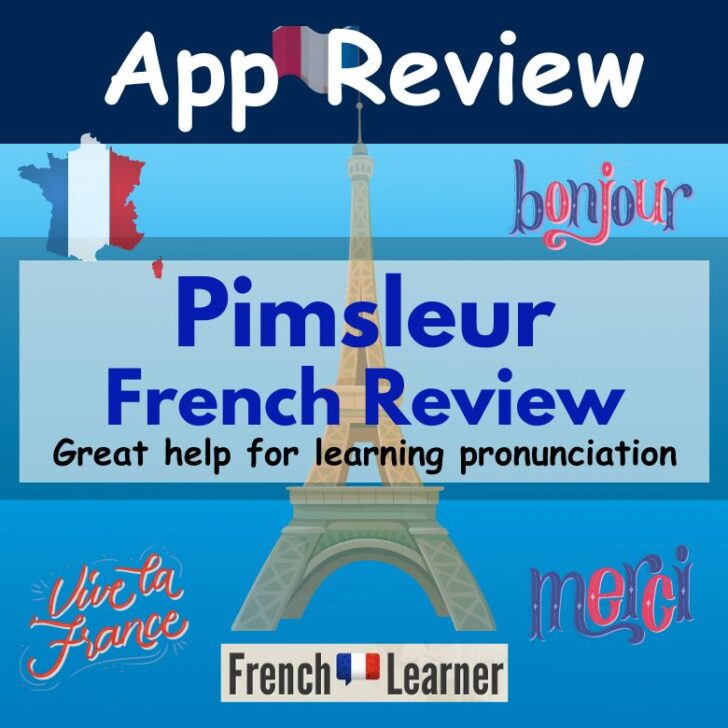I have been teaching French since 2014 and decided have a look at Pimsleur French to determine whether I’d recommend it to my students. Pimsleur is famous for the scientific “Pimsleur Method”. In short, I feel Pimsleur is a good for beginners and particularly good for those who need help with pronunciation. Keep reading.
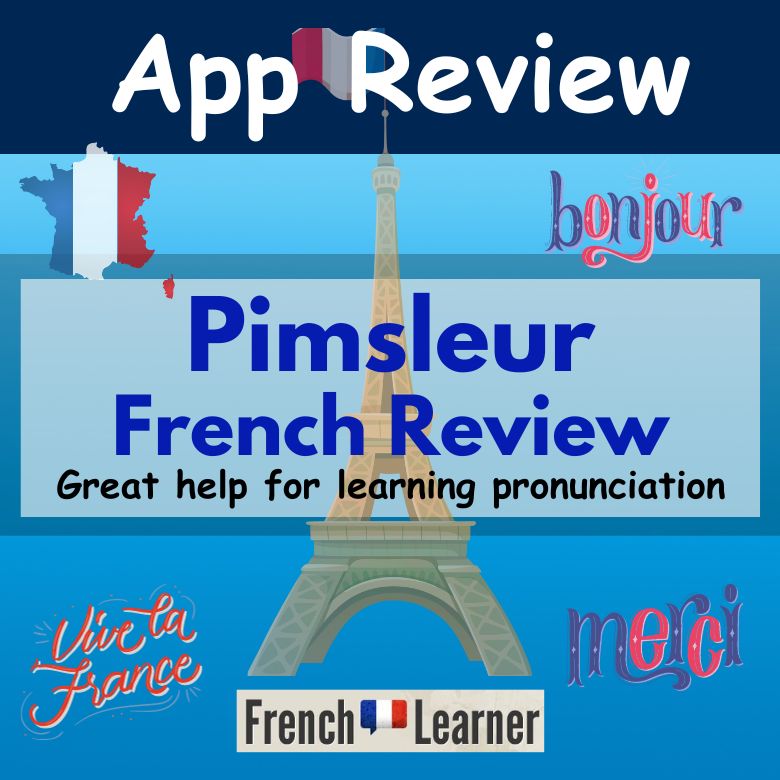
Pimsleur French Review
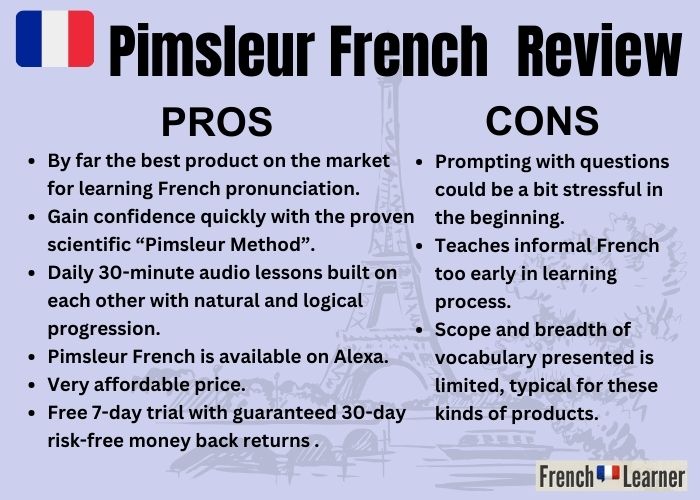
Things I like about Pimsleur French
Like many online courses and software packages, I believe that Pimsleur is a decent product with which students can get started, or to get their feet wet, so to say. The program does indeed do a good job teaching the very basics of listening, speaking and reading.
I feel that Pimsleur is a very useful tool for students who are audio learners and are focused on mastering sounds and pronunciation. Of all the online French courses I’ve looked at so far, Pimsleur by does the best job covering French phonetics.
Honestly, I don’t feel that one could speak French flunetly by using Pimsleur alone. This process takes many, many years! That said, I feel that by using Pimsleur is an excellent starting tool.
By using Pimsleur for pronunciation and reading instruction, a student can build a solid foundation for taking on greater amounts of vocabulary in the future.
I like that the lessons were created in a very specific order where each lesson builds on the words and phrases learned in previous lesson. Pimsleur designed its Premium French Course so that the student puts in about about 30+ minutes per day.
The course has a totally five levels with each level containing thirty thirty-minute lessons. Thus, there are roughly 75+ hours of lessons.
The Pimsleur Method in a Nutshell
The Pimsleur Method or approach is based on continuous listening and repeating of words and phrases of conversations and then developing reading recognition skills.
Each audio lesson starts with a short dialogue. After that, the dialogue is broken down into individual words and they’re taught with the repeat-after-me method and the constant asking of questions about what was just said.
Pimsleur uses a combination approach between audio and reading lessons, with listening ranking as the top priority. This is the “natural progression” that Dr. Pimsleur himself followed in his language courses. He puts a huge emphasis on the mastery of the sound system.
Pimsleur suggests to do one lesson per day and to do the lessons in consecutive order. Each lessons consists of a thirty-minute audio lesson followed by reading and recognition exercises.
Things I don’t like about Pimselur French
One thing I don’t like about Pimselur is that it prompts you with questions and puts you on the spot to come up with answers. As a beginner student, I might find this a bit frustrating and stressful.
Another thing I don’t like is the teaching of letter, syllable and elimination in early lessons. An example of this is Pimsleur teaching “J’suis” rather than “Je suis”, for “I am”.
This is equivalent to teaching a beginner student in English how to say, “I”m gunna”. This just isn’t necessary.
As it’s been pointed out in other reviews, Pimsleur’s scope and breadth of vocabulary presented in the totality of its course is limited. In reality and in order to speak French fluently, the student would have to take a much more aggressive approach to vocabulary building.
This would including methods such as creating vocab lists from TV show, stories or articles and engaging with a conversation partner.
In reality, an audio course or ‘product’ for learning French can’t possibly teach such a broad vocabulary of thousands of words. The motivation to take on large quantities of new vocabulary words has to come from the student him or herself.
The company’s website claims that it can have the student speaking with a “with a near-native accent”. The reality is that language learning is extremely difficult and only a small percentage of the population is able to hear sounds in a foreign language and reproduce them with a near-native accent.
Finally, as a lifelong language learner, I like to approach verbs the traditional way by learning the verb groups (regular and irregular) in their respective tenses. I didn’t see a decent presentation of the verbs in the Pimsleur French course and believe this would have helped students a lot.
How much does Pimsleur French cost?
Pimsleur offers a 7-Day money-back risk-free trial period to the Full Pimsleur Premium French Course at no cost. After that, there is a monthly charge of $19.95. Pimsleur has recently lowered its costs to make its courses more affordable.
Downloading the Pimsleur App
You can do the Pimsleur course both on your computer or on your cell phone. To download the app to to your Apple App store or Google Play. One great aspect about the app is that there’s an option listening to the course while driving!
Pimsleur on Alexa
You can also do the course on Alexa. To access the course you must enable Pimsleur under Your Skills in Alexa. You will then be promted to sign into your Pimsleur account.
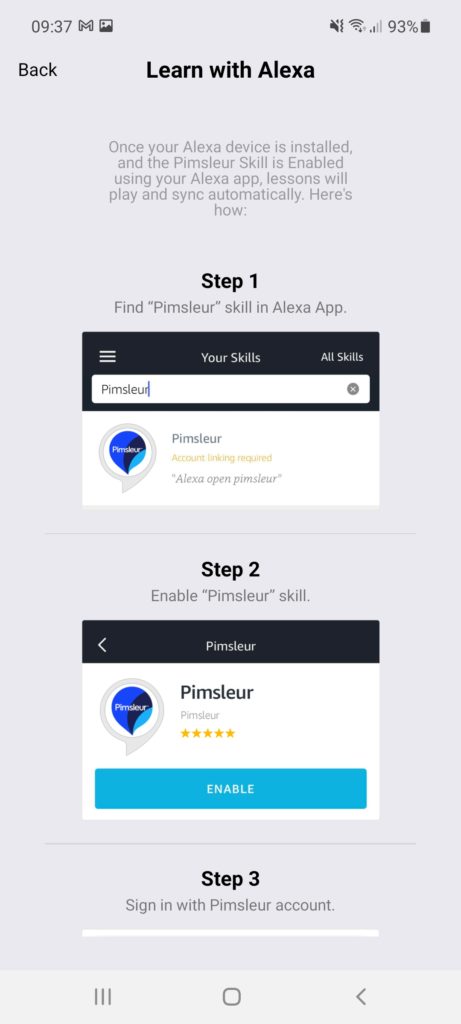
Pimsleur French: Complete lesson overview
Each lesson starts with a short conversation. The dialogues are just a few lines long and always introduce a new word or phrase. The course does a very good job building on and incorporating words from previous lessons into new lessons.
Following the quick conversation, a narrator will prompt you over the course of 30 minutes to repeat specific words and phrases from the dialogue.
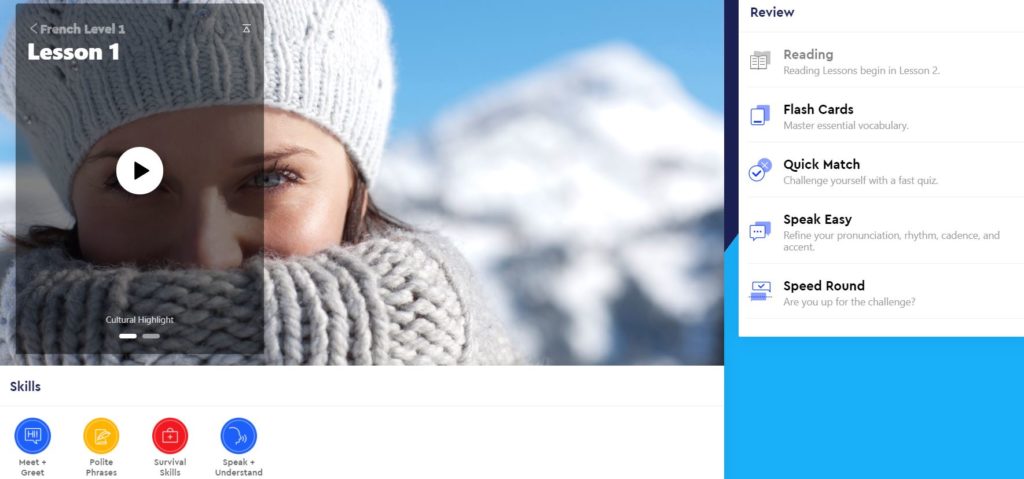
He’ll also ask you questions and to provide and ‘next line’, as if you were engaged in the dialogue yourself. This is the essence of the Pimsleur Method, where the company argues strongly that student’s engagement with the audio course is key to making progress.
Under the conversation’s play icon you’ll find icons for fast-fowarding and rewinding by ten seconds. This is helpful for re-playing words and phrases and skipping over sections that you may have already mastered.
How the reading sections work
At the end of each lesson there is an option to click on “Reading” in the upper-right part of the screen. Early on in the the course, Pimsleur presents a list of works based on related spellings and sounds. Here, Pimsleur does a marvelous job teaching French phonetics.
The French sound system is extremely tricky and this is one of the best and most methodical presentations I’ve seen.
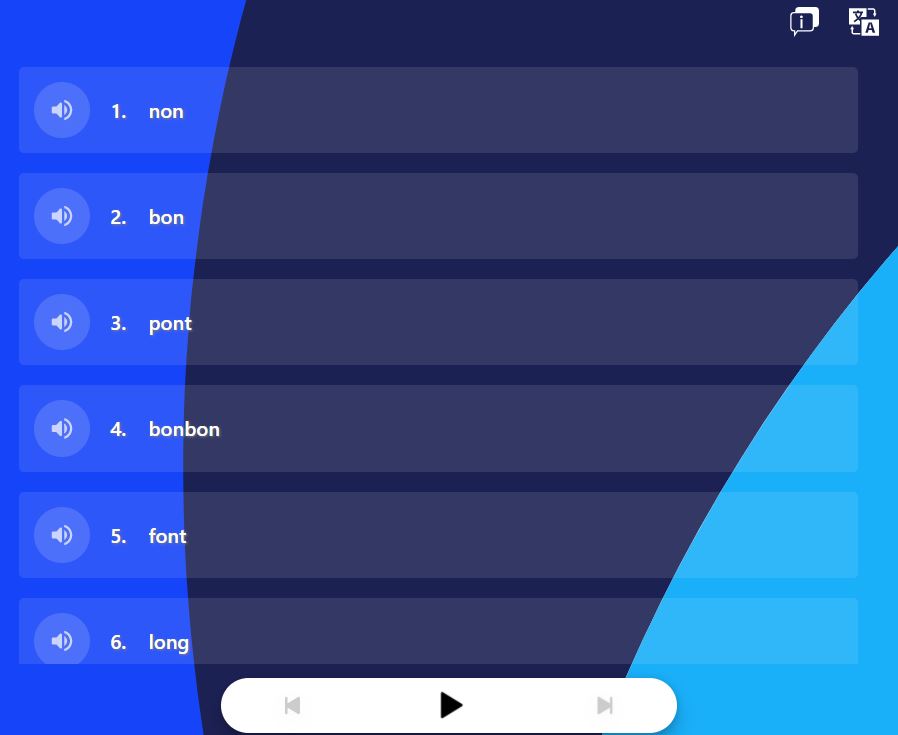
The Reading section offers a list of words which you can click on and repeat as many times as you’d like. Again, each list is based on specific sounds that are unique to French.
The course presents the alphabet and French sound systems. Given that both English and French uses the same alphabet, Pimsleur puts a heavy emphasis on learning the French sounds for the letters and letter combinations. They recommend first trying the readings without looking at the translations using French sounds.
After listening to the entirety of each audio segment, clickable icons appear at the bottom of the lesson under “skills”. Here words and phrases are broken down into different category, such as Meet + Greet or Polite Phrases.
You can click on any individual word or phrase from the dialogue and listen and repeat as many times as you’d like.
How the Flash Cards work
After listening to each audio lesson you’ll also find an option to do flash cards on the upper-right of the screen. Each word is presented in either English or French with both visual and audio.
Click on the card itself to see the meaning on the reverse side. You can set aside cards you don’t get and re-do them as many times as you’d like.
How quick match works
At the end of each audio lesson you can also do a quick match drill. Here, Pimsleur presents English phrases in both audio and written forms. Your job is to select the matching French phrase out of several options. Each French phrase has an audio icon so listen before selecting your answer.

How Speak Easy works
At the end of each audio lesson you’ll also have the option to the Speak Easy drill. Speak Easy combines multiple lines of the conversation with in both written and audio forms. You can listen and read through the entire dialogue or click on individual lines and listen individually.
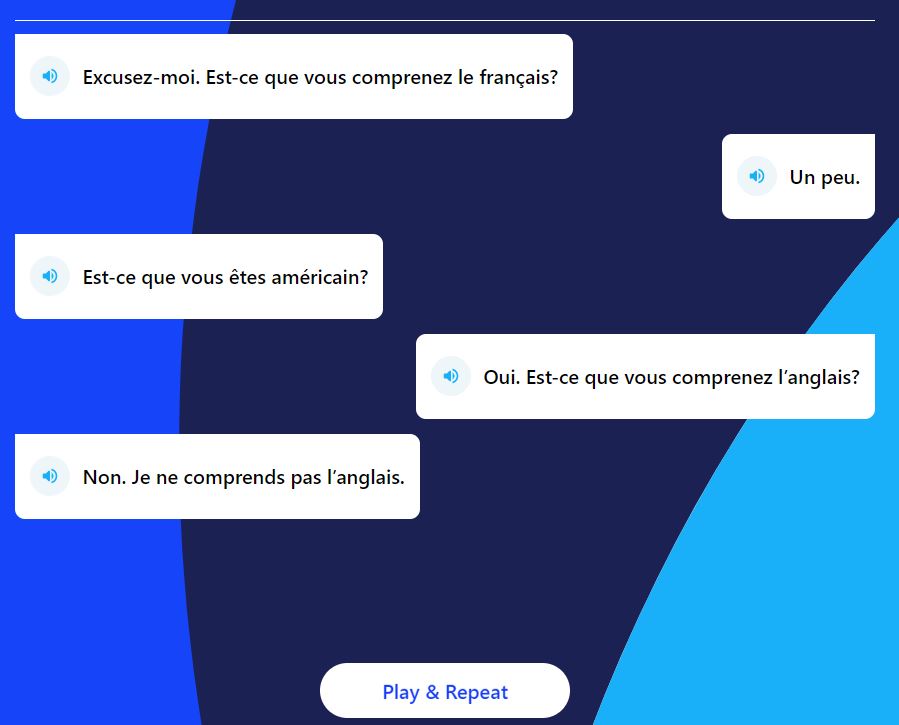
How Speed Round works
The final drill after each audio lesson is a Speed Round game. Here, you’ll see words from the conversation being presented in English in succession. Your job will be to pick the English equivalents at the bottom of the screen. Pimsleur presents your score at the end of the game.
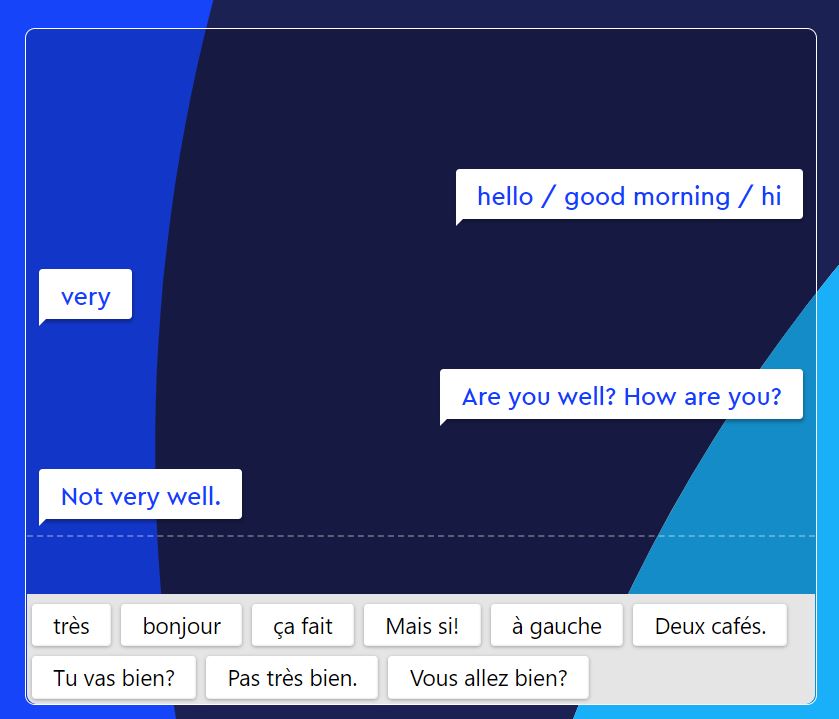
How the Skills and Me area works
At the top of your screen you’ll see a Skills section. Here the entire level you’re on is broken down into titled vocabulary lists, such as food, family and friends, travel, etc. If you click on any of these vocab categories you’ll find lists of words and phrases.
The items that come up on these lists will only appear after you’ve covered them in the lessons. You can click on any of the words and phrases, listen and repeat.
The right of each word or phrase you’ll see a paper icon with a plus symbol. Click on that icon and that specific word or phrase will get added to your personal vocabulary list, which you access by clicking Me at the top of your screen.

Who was Paul Pimsleur?
Dr. Paul Pimsleur was a linguistics and French professor who lived from 1927 through 1975. Dr. Pimsleur was born in the United States to a French-speaking father and an American mother.
Dr. Pimsleur taught at both UCLA and Ohio State. He specialized in French phonetics and researched and developed a process of language acquisition and learning through listening.
All of the Pimsleur language programs available today including Pimsleur French Premium are based on Dr. Pimsleur’s methods and teaching. Students who’d like more information on Dr. Pimsleur and his techniques for learning foreign languages can have a look at his book, How to Learn a Foreign Language.
What other materials would work in conjunction with Pimsleur French?
As an online French teacher, I’d suggest using several other books in conjunction to the Pimsleur Premium French course.
I believe strongly that one of the best ways to learn French is to interact with live human being. In my personal online classes I enjoy using the book Exercises in French Phonics by Dr. Francis W. Nachtmann. While this book doesn’t include a CD, going over the pronunciation exercises in the book with a teacher would be extremely useful.
I also like the Discovering French series of high school textbooks by Valette-Valette. Within this books I particularly like the logical layout of the lessons, exercises and most importantly the readings and stories. I believe reading stories with a teaching is also very helpful for language learning.

